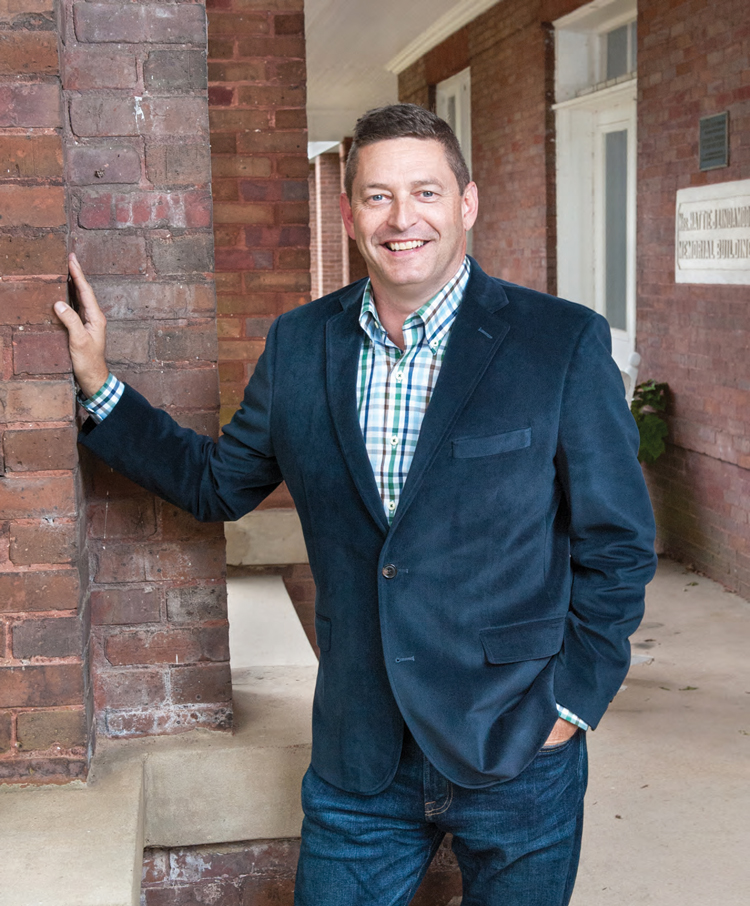Drake Bassett, CEO of Palmer Home
A Heart for Children
The Palmer Home opened its doors in Columbus, Mississippi in 1895. Its mission then, as now, was to rescue children and to restore their lives. The social fabric of our entire world has changed dramatically in the last 122 years, and those changes have multiplied the number of at risk children around the globe. Mississippi has not been spared the crisis. Drake Bassett, President and CEO at Palmer since 2012, speaks of a “revelatory” learning curve that opened his eyes to the unimaginable plight today’s children face when they are abandoned, abused, or neglected. Palmer’s mission all these years later is defined in those same original words—“to rescue and to restore.” As Drake says, “The mission hasn’t changed, but the scope has widened.”
Prior to coming to Palmer, Drake had spent a good 20+ years all over corporate America. He had entered the professional world during the technology and information revolution of the 1990’s. He worked his way up the corporate ladder through about every division as well as across America, literally, from sea to shining sea. He started with IBM in sales and ended up as the CEO with a Nielson Company based in New York City. The son of a minister and a longtime Christ follower who wanted to live out the gospel, Drake came to a defining moment when he began to look at his life and ask, “Where is the gospel in what I am doing? I had to look honestly and say, I don’t actually see myself living it out.”
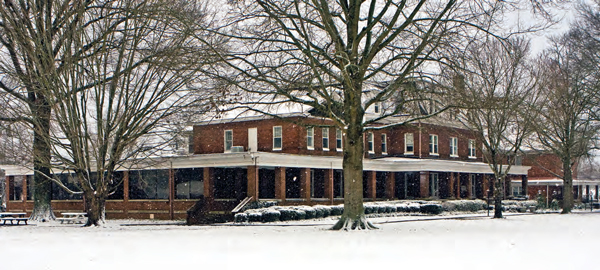
The historic Lindamood Building has welcomed thousands of children through its doors since 1895.
The good life was good, but there was something missing. Where was a gospel impact in what he did every day? He began to pray and even search online for Christian nonprofits that were looking for leaders. Drake did not feel, however, that his work in the corporate world had been wasted. If anything, he felt that the skills he had honed in the business world could possibly be valuable in the ministry world. The potential position at Palmer Home appeared much sooner than he expected, but it was clear from the first meeting between Drake and the Palmer Board of Directors that they were all on the same page.
There is energy and an enthusiasm at Palmer, something you feel from the moment you open the front door of the antebellum administration building that once upon a time housed everything and everyone that was the Palmer Home. This is such a happy place. There does not appear to be even one half-hearted soul among the staff. Everyone working here seems to be completely in love with the people and the place.
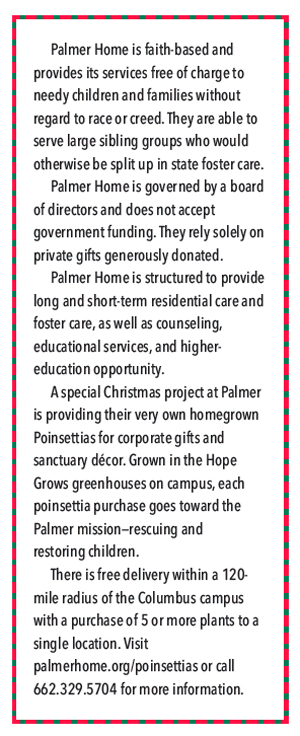 In short order, Drake, his wife Kelley, and two of their four children, Claire and Hope, became Mississippi residents. Grace and Evan, the oldest of the Bassett siblings, were already college students.
In short order, Drake, his wife Kelley, and two of their four children, Claire and Hope, became Mississippi residents. Grace and Evan, the oldest of the Bassett siblings, were already college students.
Although Drake’s corporate experience and skill had prepared him well for the business side of running a successful non-profit, nothing could have completely prepared him for the breadth and height and depth of the brokenness that characterizes the orphan world of the 21st Century. It was more complicated and individualized than the Charles Dickens’ tales of a much earlier time. Drake says, “We have really seen it all,” but he emphasizes that each child’s story has its unique nuances. His admission of a personal learning curve may be quite true, but his heart has been all in from the first day and he has never regretted the decision to be a part of the rescue and restoration of young lives. Drake has embraced the challenges while considering the immediate and individual needs of every child. It really is quite amazing. This is not a one-size-fits-all kind of place, and perhaps that is the most special and truly gospel-like thing about it!
So Many Orphans
“I came from a background obsessed with numbers and data and statistics,” Drake says, “But I had no clue of how many children were at risk in our country or how many children are in foster care.” He says that there are about 500,000 who are categorized and counted, but there are another 250,000 or so who are not classified because they are yet to be “in the system.” Those 250,000 include a growing number who are trafficked as part of an industry that nets about 150 billion dollars a year globally. Those, for obvious reasons, have not been counted. Then there are the fortunate ones who land in places like Palmer as a last hopeful refuge to avoid being handed over to a state child-welfare system. They are also yet to be counted in the statistical data available.
Drake became passionate to understand the landscape of the orphan phenomenon. Where do these kids come from? What are the factors driving these numbers because they are not shrinking—they are growing larger with every year. Every state is now overwhelmed with children at risk. “When you look at the categories of children who are self-harming, dropping out of school, committing suicide, stealing and getting into trouble, the better percentage—at least 80 percent—is coming from broken homes.”
The fallout from broken homes is not a surprise, but it is just one layer in a many-layered problem. Palmer Home understands in a profound way the heart’s desire to be loved, nurtured, protected, and valued as a member of a family. Everything at Palmer begins there. Their campuses, one in Columbus and one in Hernando, are composed of residential homes with house parents and six to eight children sharing each one. Except for the industrial-sized laundry rooms, the houses look like typical single-family homes that dot the landscapes of many a neighborhood across the country.
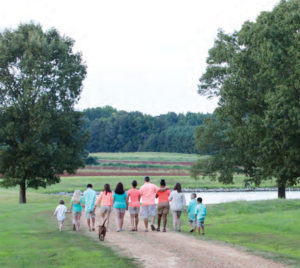
The Hernando campus, complete with
lake, also creates a sense of family and caring for every child who becomes a Palmer child.
These cottage families live like a traditional family. The atmosphere is relaxed, respectful, and feels like home. As Drake says, “We can’t replace all the things in the lives of the children here, but we can certainly create circumstances that let them see what it looks like and let them taste and touch and experience something like a loving, Christ-centered home.”
Everything is designed to help transfer values and to transform lives for all the right reasons. Nothing is more important to the Palmer team than providing the tools that will send their children into the world whole, healed, and healthy in mind, body, and spirit.
One of the first things Drake noticed when he came to Palmer was the broad support base it had built over the years. He was surprised to note that there were regular financial donors from every state in the country. As he began to call different zip codes to express his appreciation and to find out how they learned about a children’s home in Mississippi, he discovered that several of the out-of-state donors had grown up at Palmer. The stories were all different, and some of the former residents were now elderly, but each one spoke warmly of their years there. One gentleman from Maine described being placed there during World War II when his dad went overseas and did not return. His mother was forced to find work somewhere else, and she was not able to take care of her children for a period of five years. During that time, he and his sister were well loved. He added, “We’ve always been donors. We have always been grateful for our time at Palmer.”
Stories like that remind Drake of a long legacy of the integrity, honor, compassion, and authentic gospel-focused charity that have been true to Palmer’s mission. And what this special place delivers is still as potent a prescription for brokenness as it was in 1895!
The Whole Child Initiative
When Drake arrived at Palmer Home in 2012, his years of corporate experience had taught him how to put together a strategic plan as well as the ins and outs of implementing it. It was important to him to gather his team, ask a lot of questions, do a lot of listening, and to have clear goals and objectives that everyone embraced. The result was the Whole Child Initiative. It answers the fundamental question, “How are we going to care for children?”
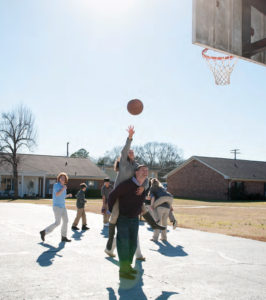
A familiar sight is Drake Bassett playing hard with the children. He relishes the opportunities to help heal hearts and rebuild trust with children who have frequently seen more than their share of disappointments.
It is noteworthy as Drake points out that the plan is not called the Whole Child Reactive! The word “initiative” is very telling. It speaks to the intent of every caregiver, teacher, counselor, and staff member at Palmer to initiate a loving and supportive environment for every child from the get-go. “You have to assume that children who are here, at a minimum, there is something wrong. Forty percent of our children have experienced some sort of physical or sexual abuse. Nearly all of our children have had some sort of emotional abuse. We decided to focus on four key areas: the physical, the emotional, the educational, and the spiritual.”
Those are the specific areas to which the Palmer team gives its whole heart!
Many of the children come to Palmer malnourished. Most have not seen a physician or a dentist regularly, if ever. The physical evaluation is immediate and complete. Whatever the need, it is provided.
The emotional hurts the children have suffered are across the spectrum from mild to severe. Licensed counselors are on campus, and therapy starts right away and usually continues as long as the child lives at Palmer.
 The educational piece is very interesting, and this is one of the many places Drake’s innovative leadership shines brightest. For several decades, the Palmer children attended the Columbus public schools. The many-layered orphan crisis of recent years presented new dilemmas.
The educational piece is very interesting, and this is one of the many places Drake’s innovative leadership shines brightest. For several decades, the Palmer children attended the Columbus public schools. The many-layered orphan crisis of recent years presented new dilemmas.
In stable homes, parents cheer their children’s achievements, pitch in, and help with homework when needed, but when a child is living in a hotel or in the back seat of a car and the mom is addicted to drugs or the father is abusive, there is not any homework supervision or anything else that promotes learning.
Unstable situations from which many children come mean that there have often been huge gaps of time when they were likely not in school at all. Children arrive as twelve-year-olds who may not have attended school in three or four years. The discrepancy between their chronological age and grade level skills can skew all over the place. What is the solution when a sixth grader reads on a first-grade level or a fourth grader reads well for his age but cannot add the simplest single digits?
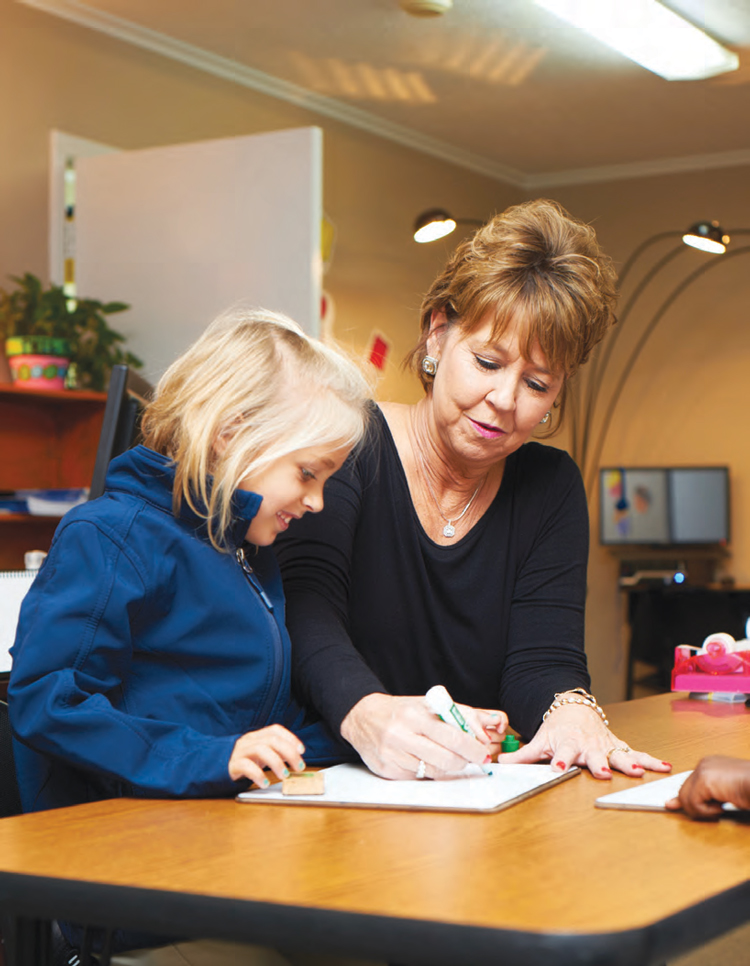
Veteran teacher Pam Abrams finds great satisfaction in helping her students discover their God-given talents. Many of them have never had that one encouraging adult in their lives who actively works with them to succeed.
For Drake, there was no question that he had to come up with something that would really enable these children to succeed. How could he help them catch up?
He approached Pam Abrams, a well-known and well-loved retired local schoolteacher. He believed they could create an individualized curriculum for each child. Sure, it would be challenging. Sure, it would take patience and a lot of work, but in his heart of hearts, he knew these children were so worth whatever it took.
He laughs when he says he imagines Pam Abrams left his office that first day thinking he just might be slightly crazy, but she came back later and agreed to give it a try. She is in her fifth year as Director of Education overseeing the individualized education of 42 students this year. She calls it, “the most rewarding job I’ve ever had. It’s a different situation, because not only can I meet the child where they are, I have the chance to work one-on-one with each child on social skills, manners, etc. I can give them the attention they need. It’s more than just a job. Every little thing I say makes a difference for these children.”
Pam’s passion is typical of everyone who is part of the Palmer team. Maybe that enthusiasm starts at the top.
Drake stresses to his staff that they have a window of time in each child’s life. They are never sure when a child comes to them how long that window of time might be. It could be a year; it could be ten years, but from the moment a child walks through the door, he says, “Game on. It’s our moment to invest everything into the life of that child—everything that is important to help them break the cycle and to go on and become one of the many success stories.”
The Spiritual Component
The fourth arm of the Whole Child Initiative is the spiritual focus. It is the one Drake considers most important. Although everything in the literature about Palmer Home states unapologetically that it incorporates a Christian worldview into every facet of life there, much of the spiritual values training the children receive is “caught” through observation and through experience.

Equine therapy has been a part of a Palmer child’s life almost from the start. there are stables right on the Palmer grounds, and seeing happy children riding across the campus is a familiar sight.
They “hear” the gospel in countless ways on a daily basis, but they also have the opportunity to “see” it at work through their interactions. In their cottages, they see a loving husband and wife who respect each other and the children who have been entrusted to their care. “When they see the gospel in action and they see that the adults here truly care, that they are not going to betray them or mishandle them or be unkind to them, they have a model,” Drake says.
The “family” attends church together; they pray before meals; they have “family” devotions; they share stories of their day with each other around the dinner table in the evening, a social time that also offers the first instruction most of these children have ever had in basic table manners. The house parents, like the rest of the Palmer staff, felt “called” to this place, and they take a personal interest in every child just like a loving mom and dad would do.
It is hard to wrap your mind around how alien such scenarios are too many children in the beginning. Therefore, it is impossible to overstate the impact that the environment at Palmer has on the overall healing for the hearts of the children who are fortunate to come here.
Drake tells the story of a ten-year-old boy who was brought to Palmer along with his two little sisters a few years ago. Coming out of an abusive home situation, he had already taken on the role of protector for his siblings. The little boy, who had seen way too much for a child his age, had an almost man-to-man style discussion with Drake. He had just two concerns: Were his sisters safe from their father and where would they be staying? Palmer puts a priority on keeping sibling groups together. That is one significant plus that few foster care options can promise.
 Drake says, “We’ve taken as many as six siblings at a time. When a call comes in, our answer is always ‘Bring ‘em all and we’ll figure out a way to make it work.’”
Drake says, “We’ve taken as many as six siblings at a time. When a call comes in, our answer is always ‘Bring ‘em all and we’ll figure out a way to make it work.’”
And Palmer does indeed “make it work” again and again. Although a child may be sent to Palmer on a day that feels like one of the darkest moments among a personal cache of dark memories, Drake firmly believes that child has been gifted with an opportunity. The adults around them are intentional to nurture and invest physically, emotionally, educationally, and spiritually in the life of one who has never had that before. “Over time,” says Drake, “you reap what you sow, and these children will reap big wins.”
The sprawling Palmer campus does give one a sense of a big family compound. Ages of residents range from infant to about age 20. Even those who leave Palmer to attend college (and yes, college is another plus) elsewhere have the comfort of knowing they can always come home! Bicycles and tricycles are visible everywhere across the campus, parked outside the cottages, beside the basketball court or the playground. The scene just looks like a lot of typical children are happily engaged being children. There is nothing cold, sterile, or institutional anywhere.
Christmas Traditions at Palmer
On the chilly November day we visited Palmer, there were signs that Christmas is a big deal here. Garland, bows, and boxes that appeared to be loaded with decorations were scattered about the porch, around the staircase, and in the parlor in the main building. It is clear that Christmas is celebrated in fine style here—traditions abound.
Each cottage holds its own “Open House” on a Sunday evening in early December. The children are always so proud to show visitors their “family” decorations, their Christmas tree and their very own rooms. Such a small thing is powerful for the Palmer children.

Christmas is celebrated with all the trimmings and a lot of joy at Palmer Home.
Drake describes the season as, “…especially bright. Many of our children have never seen the atmosphere of Christmas—the love, the energy, the comfort, the songs, the cookies, and the presents. It’s heartwarming. They are excited, as all children should be at Christmas. Some of the little ones who don’t even know what they’re excited about yet are so excited, and it’s fun to see.”
On a special evening before Christmas Eve, everyone gets dressed up and all the cottage families eat together in the main dining room of the administration building. The sense of anticipation and joy is in the air. A few of the children read the Christmas story from Luke. Then they gather outside on the front grounds for candle lighting, an annual tradition that has not changed over the years. Every child and every employee is recognized by name along with the date when they became a part of the Palmer family. There’s a sense of continuity, tradition, love, and, of course, family. The evening closes with the singing of “Silent Night.”
The Hernando campus shares a similar format for their Christmas tradition. Jeremy Beavers, Director of that campus says, “Christmas looks pretty much the same here as it does in most traditional homes.” The meal together is preceded by the candle light service and recognition of every child in their campus chapel.
Some of the children spend Christmas week with their sponsor families, but those who remain on campus are never slighted. Jeremy says, “Lots of presents, watching movies, and spending quality time together. If it snows, which it has three years in a row, we all look forward to sledding down the big hill behind the levy and then heading back to the cottages for hot chocolate!”
The Sheer Joy of Restoration
Drake sees the power of the gospel in countless ways day in and day out at Palmer Home. The Bible, especially the New Testament, uses thirst as a frequent metaphor to express deep longing.
 “I never understood what Jesus meant when he talked about thirst until I was here,” he says. “I have seen these children so thirsty for approval, thirsty for a look—they watch when I walk across the parking lot—you know, do I notice them? Do I call their name? They want to sit close to my wife when she comes to tutor in the school; they’re thirsty for attachment. They are so thirsty in a real way, and I watch God work through us to give them what they need.
“I never understood what Jesus meant when he talked about thirst until I was here,” he says. “I have seen these children so thirsty for approval, thirsty for a look—they watch when I walk across the parking lot—you know, do I notice them? Do I call their name? They want to sit close to my wife when she comes to tutor in the school; they’re thirsty for attachment. They are so thirsty in a real way, and I watch God work through us to give them what they need.
“I get to see breakthrough moments when you look across a room and see a child who may have started out angry or difficult, and you see them grow and stretch and change. It just warms your heart because you know it’s God, and it’s not just about managing tough kids—it’s about them growing up and understanding where they are in life and you see that they’re going to be okay.”
Drake never loses a sense of overwhelming awe from his front-row seat helping restore the hearts and souls of hurting children.
And isn’t every parent’s goal to know their children have been given the intangible tools of faith and character to face whatever their future holds—to know they are indeed going to be okay.

